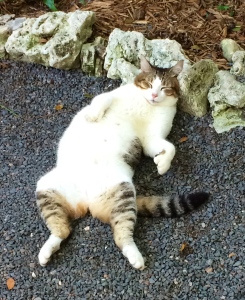
Is A Blog Mandatory?
No. But it’s advisable. You do want readers to be able to find you online and, more importantly, to find your work. You do want a website (and a mailing list, but that’s another post), but your website can be a static presence, something you put up and don’t update very often. In fact, if you have very minimal time to invest or otherwise want to limit your online presence to the bare bones, don’t include a blog. Few things look sadder than a blog with a single entry from five years ago, usually about trying to make oneself blog.
Something You Can Always Blog About
One reason to blog on your website is that it means the website is being updated frequently, which makes the site more likely to turn up on search engine results. So here’s two ways you can generate a weekly post. The first depends on having a social media presence; the second does not.
- Social Media version: If you’re posting links and observations on social media, you can collect the best of those into a post. They don’t have to be related to writing; you’re allowed to have other interests. Five to ten links with one or two sentence explanations as to why you picked them. There you go. Shazam, you have a post.
- Non Social Media version: Every week, pick an interesting chunk (I suggest 300-700 words) from what you’ve worked on the past week and post it.

- What is the project, the genre, the inspiration?
- Are those the final character/setting names or placeholders?
- What’s the title and how does it relate to the story?
- What’s the setting based on? What are you trying to accomplish in this bit?
- What are you particularly fond of?
- What do you definitely plan to go back and fix in the revision?
- What aren’t you sure about?
- What do you intend to do with the piece when you finish?
- What would you compare the piece to, either in your own work or that of others?
- What do you want readers to get out of the piece?
Certainly there are ways to get the most bang for the effort out of these posts: include an image, have a good tagging system, make the most of keywords. But those are advanced techniques, and unnecessary to this basic effort.
If You Only Hate Writing about Writing
As I mentioned above, you do not have to blog about writing. In fact, the world is full of posts about avoiding adverbs, and you probably do not have anything to say on the subject that has not already been said. So blog about something else.
Blog about your adventures in learning how to pickle vegetables or speak Mandarin. Document some longterm project like your garden remodel or the bookstore your partner is opening. In a pinch, you can always fall back on writing about the books you’re reading. The most interesting and effective blogs out there don’t just show you the writer’s writing, but something about them as a person.
Always Be Closing is NOT a Good Axiom for Writers
While all writers need to think about how to help readers find their work, if they are too pushy about forcing them to it, those readers will balk and go no further. Don’t make your website all about sell sell sell. Don’t make it your social media focus nor what you blog about over and over again. You will be wasting your time and driving away fans.
That’s why showing readers scraps from your writing is effective. You are giving them something that is (hopefully) genuinely interesting here and now. If they like it, they may look for it later on when it comes out. Let your writing and its quality do the work of selling for you and don’t worry about the set of steak knives. Just write.
#sfwapro






71 Responses
RT @Catrambo: How to Blog Without Really Trying But Still Managing Not to Be Half-Assed About It: https://t.co/pVDxDFrK3S
RT @Catrambo: How to Blog Without Really Trying But Still Managing Not to Be Half-Assed About It: https://t.co/pVDxDFrK3S
@Catrambo I was pondering this very thing today. Thank you!
RT @Catrambo: How to Blog Without Really Trying But Still Managing Not to Be Half-Assed About It: https://t.co/pVDxDFrK3S
I need to follow this…I’ve been so pathetic with blogging.
Luckily for you, I provide an easy way to do it! You post such great links about autism and child-raising and neuro-atypical stuff, I’d love to see you collecting some of that.
Awright…I’m totally doing it.
You do make it easy. I get bogged down in thinking I have to do all the complex, time-consuming steps I don’t really have to do.
RT @Catrambo: How to Blog Without Really Trying But Still Managing Not to Be Half-Assed About It: https://t.co/pVDxDFrK3S
Catherine Lundoff liked this on Facebook.
Jen Dornan-Fish liked this on Facebook.
Dave Heyman liked this on Facebook.
Danielle Myers Gembala liked this on Facebook.
Blair MacGregor Woodall liked this on Facebook.
Trent Walters liked this on Facebook.
Elmdea Adams liked this on Facebook.
Kris Millering liked this on Facebook.
Laura J Mixon liked this on Facebook.
John McColley liked this on Facebook.
Darin Calhoun liked this on Facebook.
Barbara Ann Caldwell-Pease liked this on Facebook.
Megan Lee Hosa liked this on Facebook.
Esther Hazleton liked this on Facebook.
Raven Oak liked this on Facebook.
S. Hutson Blount liked this on Facebook.
For Writers: How to Blog Without Really Trying But Still Managing Not to Be Half-Assed About It https://t.co/7vxY1OcKNd
RT @Catrambo: How to Blog Without Really Trying But Still Managing Not to Be Half-Assed About It: https://t.co/pVDxDFrK3S
Mike Pope liked this on Facebook.
Zander Vyne liked this on Facebook.
Teresa Frohock liked this on Facebook.
Brianne Sorendo liked this on Facebook.
Gabrielle Harbowy liked this on Facebook.
DeAnna Knippling liked this on Facebook.
Lori Deason liked this on Facebook.
C.Y. Lee liked this on Facebook.
Jaime O. Mayer liked this on Facebook.
Ramón Terrell liked this on Facebook.
Sean Forbes liked this on Facebook.
Michael Dezotell liked this on Facebook.
Nicki Harris liked this on Facebook.
This reminds me that I really need to stop half-assing my blog and get with the program already.
RT @Catrambo: How to Blog Without Really Trying But Still Managing Not to Be Half-Assed About It: https://t.co/pVDxDFrK3S
Andy Dudak liked this on Facebook.
Stephen Gold liked this on Facebook.
Katherine Sanger liked this on Facebook.
Kelson Philo liked this on Facebook.
Steven Gomez liked this on Facebook.
HT blog w/out really trying: https://t.co/0UYra0wL90
Sophy Zs Adani liked this on Facebook.
Sylvia Spruck Wrigley liked this on Facebook.
Beth Morris Tanner liked this on Facebook.
Jamie Todd Rubin liked this on Facebook.
Betty Cross liked this on Facebook.
Stephen Gordon liked this on Facebook.
Stephanie Charette liked this on Facebook.
Rebecca Schwarz liked this on Facebook.
Rachel Sinclair Hunt liked this on Facebook.
Kelly Sandoval liked this on Facebook.
Meryl Ferguson liked this on Facebook.
That photo looks like Xerxes catspreading.
That’s one of the cats at the Hemingway Home in Key West.
Richard Becker liked this on Facebook.
Eva Eldridge liked this on Facebook.
Julie McGalliard liked this on Facebook.
Debbie Mumford liked this on Facebook.
Scott H. Andrews liked this on Facebook.
When you suggest posting snippets of your writing, does that then make that particular piece of writing on a whole ineligible for publishing in places that don’t accept previously published work? I have seen a lot of publications lately that won’t even consider something that was shared with patrons only on a patreon, so I’m curious. I love the idea of sharing bits of WIPs because it sort of keeps you accountable, too.
If you put up a whole work, it is indeed considered publishing it. However, if you’re doing only a few paragraphs, that’s fine (unless it’s a flash and that’s the whole story.)